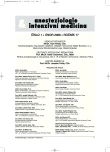Oxygen transfer and pulmonary hypertension as predictors of early mortality in lung transplant patients
Parametry přenosu kyslíku a plicní hypertenze jako prediktory časné mortality pacientů po transplantaci plic
Cíl studie:
Vyhledat měřitelné faktory předvídající přežívání pacientů po transplantaci plic.
Typ studie:
Retrospektivní klinická studie v jednom centru.
Název a sídlo pracoviště:
Klinika anesteziologie a resuscitace UK 2. LF a IPVZ, FN Motol, Praha.
Materiál a metody:
Do studie bylo zahrnuto 47 pacientů po transplantaci jednoho či obou plicních křídel, u kterých jsme se pokusili vyhledat faktory předvídající nepříznivou prognózu. Hodnoceno bylo PaO₂, střední tlak v a. pulmonalis a hypoxemický index. Data byla zjišťována předoperačně a potom 2, 24 a 48 hodin po operaci. Hodnocení log rank testem, α = 0,05.
Výsledky:
Dva faktory byly spojené se statisticky významně vyšší mortalitou transplantovaných pacientů. Byly jimi horší pooperační parametry oxygenačních plicních funkcí reprezentované v naší studii hodnotami hypoxemického indexu a v pooperačním období přetrvávající vyšší hodnoty středního tlaku v a. pulmonalis.
Závěr:
Naše studie prokázala význam zvýšených hodnot středního tlaku v a. pulmonalis a snížených hodnot hypoxemického indexu v časné pooperační fázi, jakožto nepříznivého prognostického faktoru spojeného se zvýšenou mortalitou pacientů po transplantaci plic.
Klíčová slova:
transplantace plic – plicní hypertenze – hypoxémie
Authors:
D. Romportl 1; Z. Havelka 1; A. Hodek 1; M. Pelichovská 1; I. David 3; R. Lischke 2
; J. Šimonek 2; K. Cvachovec 1; P. Pafko 2; M. Hladíková 4
Authors‘ workplace:
Klinika anesteziologie a resuscitace UK 2. LF a IPVZ, FN Motol, Praha
1; III. chirurgická klinika UK 1. LF, FN Motol, Praha
2; Nottingham, Velká Británie
3; Ústav lékařské informatiky UK 2. LF a IPVZ, FN Motol, Praha
4
Published in:
Anest. intenziv. Med., 17, 2006, č. 1, s. 14-20
Category:
Anaesthesiology - Original Paper
Overview
Objective:
To identify measurable predictors of survival in patients after lung transplantation.
Design:
Retrospective monocentric clinical study.
Setting:
Department of Anaesthesiology and Resuscitation of the 2nd Medical School and the Institute for Postgraduate Medical Education, Charles University Prague-Motol.
Material and Methods:
47 patients after single and double lung transplants were included. PaO₂, mean pulmonary artery pressure and hypoxemic index were selected as the possible survival predictors. The assessed data were collected preoperatively and 2, 24 and 48 hours postoperatively, and analysed using log rank test, α = 0.05.
Results:
Two factors predicting statistically higher mortality were identified: poor postoperative oxygenation expressed as low hypoxemic index, and persisting postoperative elevation of the mean pulmonary arterial pressure.
Conclusion:
Our study showed the significance of persisting postoperative elevated mean pulmonary arterial pressure and low hypoxemic index as factors predicting higher mortality in patients after lung transplants.
Key words:
lungs transplants – pulmonary hypertension – hypoxemia
Labels
Anaesthesiology, Resuscitation and Inten Intensive Care MedicineArticle was published in
Anaesthesiology and Intensive Care Medicine

2006 Issue 1
Most read in this issue
- Vascular anaesthesia at the beginning of the third millenium
- The cardiovascular system in the elderly and perioperative risk
- Antifibrinolytic agents in off-pump cardiac surgery: analysis of blood loss, safety and cost-effectiveness
- The prospective study on the effect of a preemptive long-term postoperative administration of a low-dose ketamine on the incidence of chronic post-mastectomy pain
